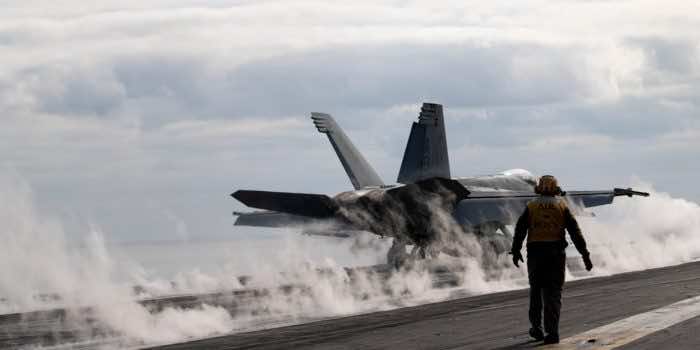It has been reported that one of the most sophisticated fighter jets in the world, i.e., the F/A-18 Super Hornet, underwent an unforeseen event on July 8 over the Mediterranean Sea. The aircraft slipped from the deck and ditched into the sea off the aircraft carrier named “USS Harry S. Truman”. The incident was totally unexpected for the crew on board as the extreme weather came out of the blue. Due to the heavy winds, the fighter jet was blown off the carrier, thereby injuring one sailor on board. The accident happened when Truman, along with “Carrier Air Wing 1″, was carrying out a “replenishment-at-sea” over the Mediterranean.
However, the authorities are engrossed in the investigation of the incident while it has been reported that the incident spurred a loss of $74 million for the U.S. government. As per the Navy press release, “The mission was safely terminated through established procedures. One sailor received minor injuries while conducting operations during the unexpected heavy weather. The sailor is in stable condition and expected to make a full recovery. ” Through this, we can say that the sailor has primarily been injured due to the replenishment exercise.

Coupled with this, Trumen is fit and is capable of doing the tasks for which it has been designed in an efficient manner. The incident, however, did not impact its operational activities and it still performs as it previously did. It should be noted that this beast is capable of carrying around 40–44 strike fighters on an exercise, while a typical Super Hornet weighs about “14.7 tonnes unloaded and 32 tonnes loaded.” As per Craig Hooper of the Themistocles Advisory Group, “You have got to always be ready to face heavy weather at sea. The Navy has put a lot of work into avoiding heavy weather. We forget that a simple storm can be more effective than a hail of missiles in mission-killing a fleet. Aircraft are not the only things that can be lost at sea—heavy seas can break antennas, radars, and other sensors that matter far more than a basic fighter aircraft. “

Normally, the aircrafts have been chained to a sturdy position or knob to make them remain static during maritime activities on an aircraft carrier and hence not be affected by any prevailing weather conditions like strong winds and thunderstorms. In the case of the Super Hornet, we have not found any credible information on whether it was being hooked down at that time or not. Hooper, on the other hand, remembers the 1944 “Halsey’s Typhoon,” which “killed almost 800 sailors and ripped several aircraft off carrier decks.” “[Cobra] really hammered home the perils of sailing into a storm,” according to Hooper.


